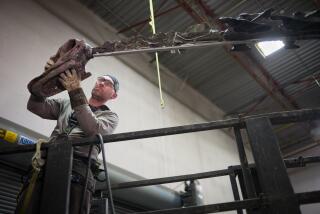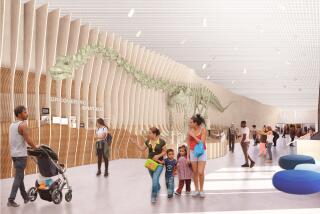Museum to Debut ‘New’ Triceratops
- Share via
WASHINGTON (AP) — A 65-million-year-old star is having a coming-out party after a computerized face-lift.
Triceratops is emerging as a brand new dinosaur at the Smithsonian’s National Museum of Natural History.
The three-horned dinosaur returns to public view today with the unveiling of a full-size cast of the 23-foot-long animal and announcement of its new nickname, “Hatcher,” named after John Bell Hatcher, the scientist who found it in Wyoming nearly a century ago.
The new display shows “how really easily triceratops could do its job. . . . It just looks like a very good animal that happens to have a whopping big head,” said museum paleontologist Ralph E. Chapman.
The museum’s triceratops may have been the first horned dinosaur to be put on display when it was opened to view in 1905, but by 1998 the bones were deteriorating, Chapman explained.
Not only did it need repairs, but over the years scientists had learned more about the dinosaur’s posture, and they had realized that the original display contained bones from other animals.
It was time for some restoration.
Triceratops was a 5- to 6-ton plant eater and was one of the last dinosaurs to live before they became extinct 65 million years ago.
While the fossilized bones had lasted all that time in nature, the rigors of museum life--heat, cold, vibration, humidity--had not been kind. There were cracks, making them fragile, and pyrite disease, a condition in which the mineral pyrite begins growing inside the fossils and breaks them.
So the giant new skeleton going on display is a polymer casting.
Never fear, though, the real bones aren’t hidden away. The exhibit “is chock-full of real material,” Chapman said. . . .
“We put the real head out there and the real humeri [arm bones] and so forth,” he said.
And what a head it is.
Apparently used for protection, and possibly fighting with each other, the museum’s triceratops had a head that would have weighed 700 pounds in real life. It displays two horns on top and a third on its nose, capping a powerful jaw.
They were plant eaters, “and boy, I’ll tell you, they had strong jaws. . . . They were overachievers when it came to chomping,” he said.
The animal’s posture is also changed a bit, with its front legs slightly splayed.
It’s what Chapman calls a “best guess” at how they looked, one that owes a lot to modern technology.
In the two-year process of developing the new display, the bones were scanned with lasers so they could be reproduced with pinpoint accuracy. The researchers then built a one-sixth scale model--a more convenient size for them to study.
When the skeleton was first displayed, the legs were shown widely splayed, much like a lizard, Chapman said. But in the 1960s and ‘70s scientists decided the legs should be more straight up.
With the scale model, Chapman and the other researchers could hold the bones in their hands and see how the joints fit together. They worked out the new slightly splayed posture using rubber bands to simulate muscles and tendons and manipulating the bones to see how each joint could move.
Essentially, they built the new Triceratops from the inside out, “letting the joint talk,” he said. You couldn’t do that with the full-size bones, he added, or “you’d need a forklift.”
The effort cost $2.2 million, all but $250,000 of which was donated, museum officials said.
Triceratops will be on display across the aisle from the museum’s Tyrannosaurus rex, a predator it may have encountered in real life.
Nearby, Chapman said, will be a juvenile dinosaur and the only head of a Diceratops in captivity, so to speak; a smaller, two-horned relative of Triceratops.
*
On the Net:
National Museum of Natural History: https://www.mnh.si.edu


